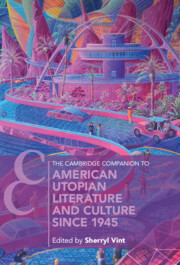Refine search
Actions for selected content:
41 results
Speculating-with Other-than-Humans in Multispecies Climate Fiction: Canopy of the Hidden Alley
-
- Journal:
- Australian Journal of Environmental Education / Volume 41 / Issue 3 / July 2025
- Published online by Cambridge University Press:
- 08 September 2025, pp. 616-632
-
- Article
-
- You have access
- Open access
- HTML
- Export citation
Chapter 1 - Plotting a Novel Industrial Infrastructure
-
- Book:
- Railway Infrastructure and the Victorian Novel
- Published online:
- 12 August 2025
- Print publication:
- 28 August 2025, pp 24-44
-
- Chapter
- Export citation
Chapter 20 - Other Worlds and Other Monies
- from Part III - Alternatives
-
-
- Book:
- Money and American Literature
- Published online:
- 03 July 2025
- Print publication:
- 17 July 2025, pp 345-362
-
- Chapter
- Export citation
Chapter 3 - On Huecos and Desaparecidos
- from Part I - Shifting Coordinates
-
-
- Book:
- Latinx Literature in Transition, 1992–2020
- Published online:
- 19 June 2025
- Print publication:
- 03 July 2025, pp 59-75
-
- Chapter
- Export citation
Chapter 10 - Latinx Speculative Fiction, Speculative Latinx
- from Part II - Transforming Genres
-
-
- Book:
- Latinx Literature in Transition, 1992–2020
- Published online:
- 19 June 2025
- Print publication:
- 03 July 2025, pp 185-201
-
- Chapter
- Export citation
Reading Climate Fiction (and Nonfiction) through First Nations Cultural Genre Theory
-
- Journal:
- Australian Journal of Environmental Education / Volume 41 / Issue 3 / July 2025
- Published online by Cambridge University Press:
- 20 June 2025, pp. 533-545
-
- Article
-
- You have access
- Open access
- HTML
- Export citation
Chapter 19 - Asian American Realism
- from Part IV - Locations of Realism
-
-
- Book:
- Realism and the Novel
- Published online:
- 05 June 2025
- Print publication:
- 19 June 2025, pp 272-285
-
- Chapter
- Export citation
Chapter 18 - Doris Lessing
- from Part III - 1945–1975
-
-
- Book:
- The British Novel of Ideas
- Published online:
- 05 December 2024
- Print publication:
- 12 December 2024, pp 308-321
-
- Chapter
- Export citation
Chapter 14 - Renewing Democracy
-
-
- Book:
- The Cambridge Companion to American Utopian Literature and Culture since 1945
- Published online:
- 09 May 2024
- Print publication:
- 16 May 2024, pp 254-270
-
- Chapter
- Export citation

The Cambridge Companion to American Utopian Literature and Culture since 1945
-
- Published online:
- 09 May 2024
- Print publication:
- 16 May 2024
4 - Afrofuturism and the Speculative Turn
- from Part II - African American Genres
-
-
- Book:
- The Cambridge Companion to Contemporary African American Literature
- Published online:
- 14 December 2023
- Print publication:
- 21 December 2023, pp 81-95
-
- Chapter
- Export citation
Coda
-
- Book:
- Black Women and Energies of Resistance in Nineteenth-Century Haitian and American Literature
- Published online:
- 09 November 2023
- Print publication:
- 23 November 2023, pp 156-161
-
- Chapter
- Export citation
Chapter 24 - The Underground Railroad (2016): Colson Whitehead
- from Part III - Case Studies
-
-
- Book:
- The Cambridge Companion to the Twentieth-Century American Novel and Politics
- Published online:
- 07 October 2023
- Print publication:
- 12 October 2023, pp 341-349
-
- Chapter
- Export citation
12 - African American New History-Writing in Graphic Narratives
- from Part II - Graphic Novels and the Quest for an American Diversity
-
-
- Book:
- The Cambridge Companion to the American Graphic Novel
- Published online:
- 10 January 2024
- Print publication:
- 28 September 2023, pp 210-225
-
- Chapter
- Export citation
Jinn and Jins: Sensuous Piety as Queer Ethics
-
- Journal:
- Cambridge Journal of Postcolonial Literary Inquiry / Volume 11 / Issue 2 / April 2024
- Published online by Cambridge University Press:
- 10 August 2023, pp. 123-147
-
- Article
-
- You have access
- Open access
- HTML
- Export citation
Chapter 15 - From Nothing to Something
- from Part III - Readings in Genre, Gender, and Genealogies
-
-
- Book:
- Diaspora and Literary Studies
- Published online:
- 20 July 2023
- Print publication:
- 10 August 2023, pp 270-284
-
- Chapter
- Export citation
30 - The Making of the Asian Australian Novel
-
-
- Book:
- The Cambridge History of the Australian Novel
- Published online:
- 28 June 2023
- Print publication:
- 27 July 2023, pp 502-519
-
- Chapter
- Export citation
18 - Australian Fiction in the Anthropocene
- from Part III - Futures
-
-
- Book:
- The Cambridge Companion to the Australian Novel
- Published online:
- 03 March 2023
- Print publication:
- 02 March 2023, pp 289-304
-
- Chapter
- Export citation
Chapter 3 - Speculative African Slaveries
- from Part II - Forms and Figures
-
-
- Book:
- The Cambridge Companion to Global Literature and Slavery
- Published online:
- 15 December 2022
- Print publication:
- 22 December 2022, pp 49-61
-
- Chapter
- Export citation
Chapter 5 - Speculative Fiction
- from Part II - New Genres
-
-
- Book:
- Latin American Literature in Transition 1980–2018
- Published online:
- 24 November 2022
- Print publication:
- 08 December 2022, pp 79-92
-
- Chapter
- Export citation
